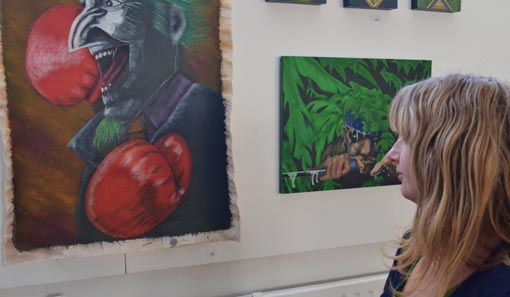How exhibiting can support prisoner rehabilitation

29 April 2013
“It’s a bit scary, to be honest, because I don’t like to get criticised. A heap of stress, a heap of worry, a heap of anxiety. Then it all goes away and it turns into a heap of joy,” says one of the prisoners whose work featured in the recent student exhibition at The Learning Connexion in Lower Hutt.
 At the end of each term, The Learning Connexion presents an exhibition of their students’ art. Work by prisoners studying art through The Learning Connexion’s distance-learning processes features alongside the other students’ work.
At the end of each term, The Learning Connexion presents an exhibition of their students’ art. Work by prisoners studying art through The Learning Connexion’s distance-learning processes features alongside the other students’ work.
Feedback from exhibiting prisoners shows that the experience can be challenging but ultimately rewarding when they see photos of their work on display.
Sharon Hall, Restricted Programmes Co-ordinator and Distance Delivery Mentor at The Learning Connexion, oversees approximately 80 prisoners studying art from Corrections’ facilities around the country.
Positive contribution to rehabilitation
She says the opportunity for prisoners to have their work displayed alongside work by students “on the outside” contributes positively to prisoners’ rehabilitation and reintegration.
“It is clearly rehabilitative. All the students exhibiting their work are undertaking tertiary study – often for the first time in their lives – and their feelings of pride and sense of achievement are huge.
“The artwork is unidentifiable as coming from a Corrections facility but it’s a small step towards participating in the community again. The prisoners’ families and Corrections’ staff attend these shows to show their support.”
 In the recent exhibition, there was a marked increase in prisoners submitting work. “That’s because we’ve got increased numbers of prisoners studying at higher levels and the expectation is for them to exhibit more frequently,” Sharon says.
In the recent exhibition, there was a marked increase in prisoners submitting work. “That’s because we’ve got increased numbers of prisoners studying at higher levels and the expectation is for them to exhibit more frequently,” Sharon says.
“Submitting work into the exhibition isn’t compulsory but we encourage our students to take up the opportunity.”
The exhibitions feature a wide range of subject matter – from portraits and landscapes to more abstract works. Some students choose to extend an exercise from the course notes.
In addition, all levels of the programme are exhibited. This means that work from a Certificate student may sit alongside work from a Diploma Honours student.
Benefits of exhibiting work
The Learning Connexion Director Jonathon Milne is convinced of the benefits of prisoner students exhibiting their work in the end-of-term exhibitions.
“It’s often daunting for students to put their work on show but we encourage everyone to be involved,” he says. “Exhibitions shift attention from making art to the bigger conversations that happen when the public engages with the work.
“The process helps students focus on what is effective and also to understand that rejection is nothing more than a learning experience. The challenge is to reflect on what happens and decide what to do next. It’s about building resilience, patience and long-term goals.”
Process and skills
Artist pseudonyms are used and Sharon says that exhibiting isn’t about gaining recognition for the prisoners as artists. It’s about the process and about the skills they can gain from the experience.
“We firmly believe that making art in prison gives students the opportunity to develop and build on their existing skills. These can then be used in constructive ways to create alternative pathways for their future.
“All prisoners will be eventually released and reintegrated back into the community. With that in mind, it makes sense to encourage them to use their time constructively and creatively, with the overarching goal being rehabilitation.”
The Learning Connexion term two exhibition is scheduled for the end of June 2013 at its Taita campus.


